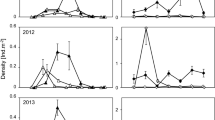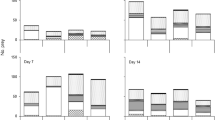Abstract
Intra and interspecific competition may influence the strength of individual specialization in resource use. We evaluated how intra and interspecific competition affects the degree of individual specialization in food resource use within sub-populations of Hoplerythrinus unitaeniatus. To do so, we identified food items from fishes collected in the Pantanal wetland. We tested whether individual specialization was related to H. unitaeniatus density (a proxy of intraspecific competition) or to the density of a potential interspecific competitor (Hoplias malabaricus) using a multiple regression. Dietary variation was related to ontogeny. Hoplerythrinus unitaeniatus density, instead of Hoplias malabaricus density, had an effect on the specialization of H. unitaeniatus individuals. A greater the density of H. unitaeniatus leads to a greater individual specialization. Our results point to a lack of specialization in H. unitaeniatus individuals. In addition, intra and not interspecific competition affected the use of food resources. Individuals of denser populations may consume secondary resources, reducing the effects of intraspecific competition and becoming more specialists.


Similar content being viewed by others
References
Anderson MJ (2001) A new method for non-parametric multivariate analysis of variance. Austral Ecol 26:32–46
Araújo MS, Guimarães PR, Svanbäck R, Pinheiro A, Guimarães P, Dos Reis SF, Bolnick DI (2008) Network analysis reveals contrasting effects of intraspecific competition on individual vs. population diets. Ecology 89:1981–1993
Araújo MS, Martins EG, Cruz LD, Fernandes FR, Linhares AX, Dos Reis SF, Guimarães PR (2010) Nested diets: a novel pattern of individual-level resource use. Oikos 119:81–88
Araújo MS, Bolnick DI, Layman CA (2011) The ecological causes of individual specialization. Ecol Lett 14:948–958
Binning SA, Chapman LJ (2010) Is intraspecific variation in diet and morphology related to environmental gradients? Exploring Liem’s paradox in a cichlid fish. Integrative Zoology 5:241–255
Bolnick DI (2001) Intraspecific competition favours niche width expansion in Drosophila melanogaster. Nature 410:463–466
Bolnick DI, Yang LH, Fordyce JA, Davis JM, Svanbäck R (2002) Measuring individual-level resource specialization. Ecology 83:2936–2941
Bolnick DI, Svanbäck R, Fordyce JA, Yang LH, Davis JM, Hulsey CD, Forister ML (2003) The ecology of individuals: incidence and implications of individual specialization. Am Nat 161:1–28
Bolnick DI, Svanbäck R, Araújo MS, Persson L (2007) Comparative support for the niche variation hypothesis that more generalized populations also are more heterogeneous. Proc Natl Acad Sci U S A 104:10075–10079
Bolnick DI, Ingram T, Stutz WE, Snowberg LK, Lau OL, Paull JS (2010) Ecological release from interspecific competition leads to decoupled changes in population and individual niche width. Proceedings of the Royal Society B Biological Sciences 277:1789–1797
Bolnick DI, Amarasekare P, Araújo MS, Bürger R, Levine JM, Novak M, Rudolf VHW, Schreiber SJ, Urban MC, Vasseur DA (2011) Why intraspecific trait variation matters in community ecology. Trends Ecol Evol 26:183–192
Britski HA, Silimon KZS, Lopes BS (2007) Peixes do Pantanal: manual de identificação. 2 ed. EMPRAPA, Brasília
Carvalho LN, Fernandes CHV, Moreira VSS (2002) Alimentação de Hoplias malabaricus (Bloch, 1794) (Osteichthyes, Erythrinidae) no rio Vermelho, Pantanal Sul Mato-Grossense. Revista Brasileira de Zoociências 4:227–236
Cloyed CS, Eason PK (2016) Different ecological conditions support individual specialization in closely related, ecologically similar species. Evol Ecol 30:379–400
Dumay O, Tari PS, Tomasini JA, Mouillot D (2004) Functional groups of lagoon fish species in Languedoc Roussillon, southern France. J Fish Biol 64:970–983
Eklöv P, Svanbäck R (2006) Predation risk influences adaptive morphological variation in fish populations. Am Nat 167:440–452
Evangelista C, Boiche A, Lecerf A, Cucherousset J (2014) Ecological opportunities and intraspecific competition alter trophic niche specialization in an opportunistic stream predator. J Anim Ecol 83:1025–1034
Fernandes IM, Henriques-Silva R, Penha J, Zuanon J, Peres-Neto PR (2014) Spatiotemporal dynamics in a seasonal metacommunity structure is predictable: the case of floodplain-fish communities. Ecography 37:001–012
Fernandes IM, Penha J, Zuanon J (2015) Size-dependent response of tropical wetland fish communities to changes in vegetation cover and habitat connectivity. Landsc Ecol 30(8):1421–1434
Godoi DS (2004) Diversidade e hábitos alimentares de peixes de um córrego afluente do rio Teles Pires, Carlinda, MT, drenagem do rio Tapajós. 134 f. Dissertação (Mestrado em Aquicultura) - Universidade Estadual Paulista
Jensen H, Kiljunen M, Knudsen R, Amundsen P (2017) Resource partitioning in food , space and time between Arctic Charr ( Salvelinus alpinus ), Brown trout ( Salmo trutta ) and European whitefish ( Coregonus lavaretus ) at the southern edge of their continuous coexistence. Plos 25:1–18
Junk WJ, Silva CJ, Cunha CN, Wantzen KM (2011) The Pantanal: Ecology, Biodiversity and Sustainable Management of a Large Neotropical Seasonal Wetland. Sofia: Pensoft Publishers
Krebs JC (1994) Ecology: the experimental analysis of distribuition and abundance. 4 ed. 801 p. Harper Collins, New York
Lários MC, Cunha CN, Penha J, Landeiro VL, Pinho JB, Aragona M, Valério LM, Strüssmann C, Marques MI, Lourenço LS, Chupel TF, Fernandes IM (2017) Evidence of cross-taxon congruence in Neotropical wetlands: importance of environmental and spatial factors. Global Ecology and Conservation 12:108–118
Lima Filho JA, Martins J, Arruda R, Carvalho LN (2012) Air-breathing behavior of the Jeju fish Hoplerythrinus unitaeniatus in Amazonian streams. Biotropica 44:512–520
MacArthur RH, Pianka ER (1966) On optimal use of a patchy environment. Am Nat 100:603–609
Magnusson WE, Lima AP, Luizão R, Luizão F, Costa FRC, Castilho CV, Kinupp VF (2005) Rapeld: a modification of the gentry method for biodiversity surveys in long-term ecological research sites. Biota Neotropica 5:19–24
Martins EG, Araújo MS, Bonato V, Reis SF (2008) Sex and season affect individual-level diet variation in the neotropical marsupial Gracilinanus microtarsus (Didelphidae). Biotropica 40:132–135
Mateus L, Ortega J, Mendes A, Penha J (2016) Nonlinear effect of density on trophic niche width and between-individual variation in diet in a neotropical cichlid. Austral Ecology 41:492–500
McCafferty WP (1981) Aquatic entomology. 448p. Jones and Bartlett publishers. INC, Boston
Mittelbach GG, Osenberg CW, Wainwright PC (1992) Variation in resource abundance affects diet and feeding morphology in the pumpkinseed sunfish (Lepomis gibbosus). Oecologia 90:8–13
Mittelbach GG, Osenberg CW, Wainwright PC (1999) Variation in feeding morphology between pumpkinseed populations : phenotypic plasticity or evolution ? Evol Ecol Res 1:111–128
Mourão G, Oliveira MD, Calheiros DF, Padovani CR, Marques EJ, Uetanabaro M (2002) O Pantanal Mato-grossense. Pp. 29–47 In: Seedliger U, Cordazzo C, Barbosa FAR (Eds.). Os sites e o programa brasileiro de pesquisas ecológicas de longa duração. Conselho Nacional de Desenvolvimento Científico e Tecnológico, Belo Horizonte, Brasil
Newsome SD, Tinker MT, Gill VA, Hoyt ZN, Doroff A, Nichol L, Bodkin JL (2015) The interaction of intraspecific competition and habitat on individual diet specialization: a near range-wide examination of sea otters. Oecologia 178:45–59
Oksanen J, Blanchet FG, Friendly M, Kindt R, Legendre P, McGlinn D, Minchin PR, O'hara RB, Simpson GL, Solymos P, Stevens MHH, Szoecs E, Wagner H (2017) Vegan: community ecology package. R package version 2:4–3
Oliveira FG, (2013) Interação social cooperativa no comportamento predatório de Hoplerythrinus unitaeniatus (Agassiz, 1829) (Characiformes, Erythrinidae): influência do nível de aprendizagem associativa na eficiência das táticas de predação. 31 p. Dissertação (mestrado em Ecologia de Ambientes Aquáticos Continentais). Universidade Estadual de Maringá. Paraná
Peres-Neto PR (1995) Introdução a Análises Morfométricas. Oecologia Brasiliensis 2:57–89
Perry G, Pianka ER (1997) Animal foraging: past, present and future. Trends in Ecology and Evolution 12(9):360–364
Pires MM, Guimarães PR Jr, Araújo MS, Giaretta AA, Costa JCL, Dos Reis SF (2011) The nested assembly of individual-resource networks. J Anim Ecol 80:896–903
Polis GA (1984) Age structure component of niche width and intra-specific resource partiotioning: can age groups function as ecological species? Am Nat 123:541–564
R Core Team (2019) R: A language and environment for statistical computing. R Foundation for Statistical Computing, Vienna
Reis RE, Kullander SO (2003) Check list of freshwater fishes of south and Central America. Ferraris Júnior CJ (Org) Porto Alegre: Edipucrs, 729 p
Revelle W (2013) psych: Procedures for Personality and Psychological Research, Northwestern University, Evanston, Illinois, USA,
Schoener TW (1968) The Anolis lizards of Bimini: resource partitioning in a complex fauna. Ecology 49:704–726
Schoener TW (1971) Theory of feeding strategies. Annu Rev Ecol Syst 2:369–404
Signor CA, Fernandes IM (2010) O Pantanal e o sistema de pesquisa. Pp. 13–23 In: Fernandes, I. M., C. A. Signor & J Penha. Biodiversidade no Pantanal de Poconé. Cuiabá: Centro de Pesquisa do Pantanal, 196 p
Sih A, Christensen B (2001) Optimal diet theory: when does it work, and when and why does it fail? Anim Behav 61:379–390
Skúlason S, Smith TB (1995) Resource polymorphisms in vertebrates. Trends Ecol Evol 10:366–340
Svanbäck R, Bolnick DI (2005) Intraspecific competition affects the strength of individual specialization: an optimal diet theory method. Evol Ecol Res 7:993–1012
Svanbäck R, Bolnick DI (2007) Intraspecific competition drives increased resource use diversity within a natural population. Proceedings of The Royal Society B Biological Sciences 274:839–844
Svanbäck R, Eklöv P, Fransson R, Holmgren K (2008) Intraspecific competition drives multiple species resource polymorphism in fish communities. Oikos 117:114–124
Van Valen L (1965) Morphological variation and width of ecological niche. Am Nat 99:377–390
Werner EE, Gilliam JF (1984) The ontogenetic niche and species interactions in size-structured populations. Annual Review of Ecology, Evolution, and Systematics 15:393–425
Winemiller KO (1991) Ecomorphological diversification in lowland freshwater fish assemblages from five biotic regions. Ecol Monogr 61:343–365
Zaccarelli N, Mancinelli G, Bolnick DI (2013) RInSp: an R package for the analysis of individual specialization in resource use. Methods Ecol Evol 4:1018–1023
Zhao T, Villéger S, Lek S, Cucherousset J (2014) High intraspecific variability in the functional niche of a predator is associated with ontogenetic shift and individual specialization. Ecology and Evolution 4:4649–4657
Acknowledgments
We are grateful to Soraia Diniz, Thiago J. Izzo, Christine Strüssmann and Jean C.G. Ortega for their criticism in early versions of this manuscript. Márcio S. Araújo for constructive comment and resolution of fundamental doubts. A.M. thanks the Conselho Nacional de Desenvolvimento Científico e Tecnológico (CNPq) for a scholarship, process number 132585/2012-0.
Author information
Authors and Affiliations
Corresponding author
Additional information
Publisher’s note
Springer Nature remains neutral with regard to jurisdictional claims in published maps and institutional affiliations.
Electronic Supplementary Material
Table S1
(DOCX 10.5 kb)
Rights and permissions
About this article
Cite this article
Mendes, A., Fernandes, I.M., Penha, J. et al. Intra and not interspecific competition drives intra-populational variation in resource use by a neotropical fish species. Environ Biol Fish 102, 1097–1105 (2019). https://doi.org/10.1007/s10641-019-00892-5
Received:
Accepted:
Published:
Issue Date:
DOI: https://doi.org/10.1007/s10641-019-00892-5




